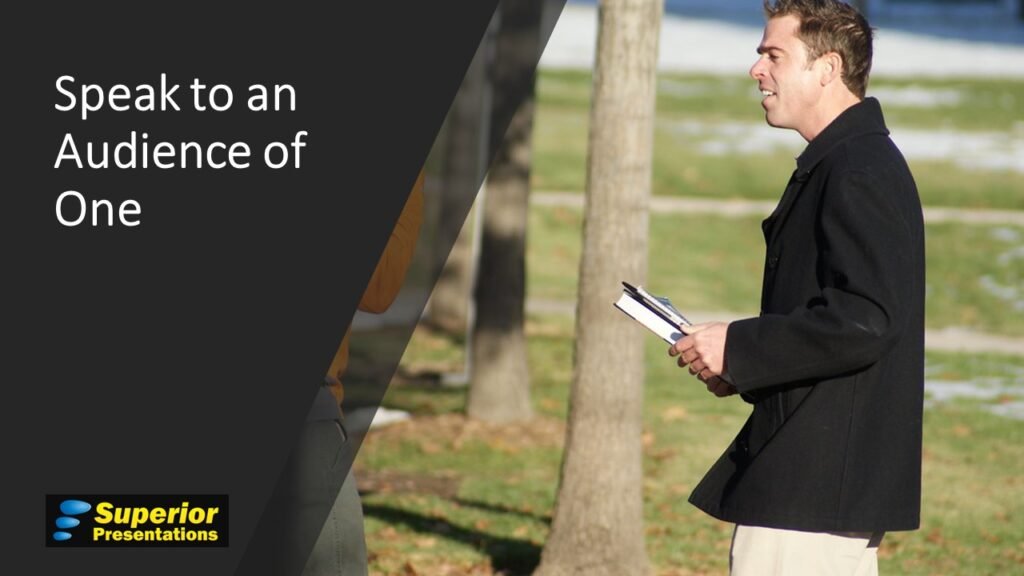Two techniques to build rapport with your audience

Two Techniques To Build Rapport With Your Audience Have you heard about horse whisperers? People who exhibit an almost mystical bond with horses. They can calm the horse. The horse trusts them and follows their guidance. Imagine if you could have that effect on your audience. Establish trust and have them follow your guidance. The way you do that is by establishing rapport. To establish rapport, the audience must believe that you understand them and share common experiences or values. Demonstrate how you are like your audience. How might you do that especially when you don’t know your audience well or believe that they are different from you for economic or sociographic reasons? Leverage Your Family Talk about your family. Tell a short story about your family. Even better if it’s funny or expresses frustration with certain family members. Why is that effective? Because everyone has family, and they typically have strong memories and feelings about family. When you talk about your family, they can connect with you because of those similar emotions. We all have family and strong feelings about family. Use your family stories to trigger those common emotions. Shared Pain A second way to build rapport is to reveal a flaw or embarrassment. Tell a short story about that. One where you are not the hero. Instead, you’re the butt of the incident. It doesn’t need to be a major flaw. When you reveal a weakness, flaw or embarrassment, you are being vulnerable. When you do that, we trust you more because it seems you have nothing to hide. The other benefit is that the audience can relate to your pain because they all have similar incidents they’d like to forget. The added benefit of sharing pain is that you demonstrate how you are imperfect just like them. Too many speakers present themselves as perfect. They believe you’ll listen better if they are perfect. The opposite is true. When a person claims they are perfect, they are lying because nobody is perfect. When you claim perfection, we hate you. But when you admit your imperfection, we can identity with you because secretly we all know we are imperfect. Be selective about which flaws you reveal and don’t tell all your flaws. You want to maintain credibility. Build rapport with your audience by demonstrating how you are like them. Imagine if you could be an audience whisperer.
Speak to an Audience of One

Speak To An Audience of One Imagine how you might feel when you’re sitting in an audience listening to a speaker and it feels like the speaker is talking directly to you. It seems more like a one-to-one conversation despite the audience present. Now imagine that you could convey that intimate feeling when you are the speaker. The secret is to speak as if you’re speaking to one person. Sounds simple yet few speakers have mastered this technique. Here are three changes to make in your presentations to connect with your audience as individuals. See them as Individuals The first step is to adjust your mindset. Don’t see a crowd or audience. Instead, see a gathering of individuals. Imagine yourself speaking to each individual one person at a time. You can get into this mindset if you great them as individuals when they arrive. You don’t need to call out every name or where they are from. Simply connect with a few. The other benefit of seeing them as individuals is that you will feel less anxious about public speaking. Mind your Words Stop using crowd language. Don’t refer to them as a crowd. “Hello everybody” is both impersonal and reinforces that they are part of a crowd. Instead say “Hello”. And don’t ask “How is everybody today?” because we know you don’t care. You’re not going to let every person tell you how they are. This question is from the Motivational Speaker 101 fake enthusiasm guide. The word” anybody” is equally distasteful, as in “anybody have any questions?” Yuk. Don’t refer to the audience as “You guys”. Instead say “You” because it is both singular and plural. Make a point to use the word “you” often during your presentation because every time you say the word, each person feels as if you are speaking directly to them. Remove plural versions of words that describe the audience. Instead of saying “as members of” say “as a member of”. Use these phrases: You and your team You and your fellow members Test your words by asking yourself, “Would this be appropriate I was sitting across the table and talking to one person?” Eye Contact When you are in the room with an audience, move your glance from one person to another and hold their eyes for a few seconds before moving to the next person. By the end of the presentation every person should feel that at some point “the speaker was talking directly to me”. Of course, if you’re speaking virtually, you stare at the glass eye of the camera to convey the same feeling. Look at the camera, not the screen. Effective eye contact is from the perspective of the audience not you. It’s not that you thought you looked at them. Did they believe you looked at them? Convey the feeling that you are speaking to one person. Imagine how each person will feel when you speak to them as individuals, not a crowd.
Open and Close your presentations

Orchestrate the first and last impressions Think about the three distinct parts of your presentation. They are the opening, body and close. The body is the major part of the presentation The opening and close might only comprise 10 to 15% of the time, yet they are critical because they convey first and last impressions. You’ve probably heard that first impressions are important. Did you know that last impressions are also important? The last impression follows the law of recency. We have selective memory, and we tend to remember firsts and lasts. We also place more importance on firsts and lasts. What does that mean to you as a presenter? Spend more time and effort getting your opening and close right. When creating your opening and close, consider the possibility that they might only remember these two parts. If that was true, would they have received your intended message? If not, revise your opening and close. The body is the detail, the opening and close provide the motivation and the direction. Rehearse your opening and close separately so you can deliver them confidently and effectively. If you are using slides, blank the screen during the opening and closing because you want to be the focal point. You want the audience focused on you during your opening and closing so your message is received, understood and remembered. Don’t allow a slide to interfere with your messages during these key parts of the presentation. What are common mistakes you can avoid in the opening and close? What are effective techniques and specific phrases you can use? Watch for the answers to these questions in the next set of presentation tips. When you speak, create and convey the first and last impressions that support your message.